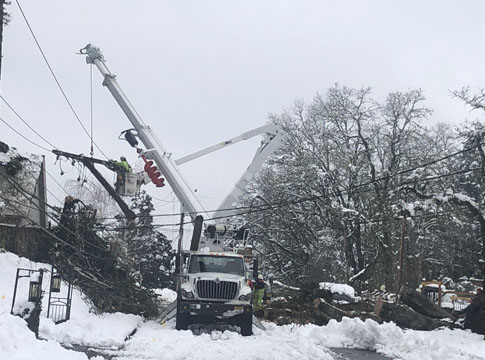Related News
Related News
-
Let's Talk Turkey. Is your family ready for winter?
We're heading into the holidays, but that also means snow, ice, and not-so-nice weather might be in the forecast. Here are some tips to prepare in advance.
Find Out More -
EWEB Partners with Eugene School District 4J to Celebrate New Kennedy Middle School Emergency Water Station Site
Hundreds of attendees practiced filling up water containers at Saturday's demonstration event.
Find Out More -
Electric Projects underway in North & South Eugene
Underground lines and disaster-resilient power poles are part of EWEB’s infrastructure upgrade near Eugene’s largest natural resource area.
Find Out More -
Join the Pledge to Prepare
When you think about getting ready for an emergency, you probably have questions. You aren't alone. Preparing for emergencies can be overwhelming, which is why EWEB has put together a 12-month program to help you and your family get two weeks ready.
Find Out More -
You can’t predict the next disaster, but you can prepare
The earthquake lasted less than a minute. But now the power’s out. The tap runs dry. Cell service is spotty. Would you be ready?
Find Out More -
EWEB prepares for wildfire season with risk mitigation measures
EWEB is building a more resilient electric system to weather various types of disasters, from wildfire to winter storms.
Find Out More -
EWEB Pilots New Line Safety Program for 4th graders.
This year, EWEB is ramping up power line safety for children, specifically 4th graders.
Find Out More -
Hayden Bridge celebrates 75 years of service as EWEB looks forward to a new era of water resiliency
EWEB Water Treatment Supervisor, Toby Dixon, looks back at how the Hayden Bridge Water Filtration Plant has changed over the years and explains what EWEB is doing to secure a more resilient water future.
Find Out More -
Watch the Recording: Financial Preparedness for Disasters
How will you financially recover after a disaster? This seminar gives key insights into preparing your finances ahead of time.
Find Out More -
EWEB reaffirms commitment to resilience with Wildfire Mitigation Plan approval
The utility is testing new equipment, leveraging technology, and incorporating third-party expertise to bolster electric system resiliency to a range of threats, including wildfire.
Find Out More -
Energy demand reaches highest level in nearly a decade as utility prepares for ice
Frigid temperatures in the low 20s caused surging electricity demand in early February.
Find Out More -
Recovery still ongoing on the anniversary of the 2024 Ice Storm
Cost of rebuilding EWEB's electrical system will surpass $11 million
Find Out More -
EWEB awarded $1 million for wildfire resiliency projects from Federal funding package
Funds will be used to support fuels reduction work on a landscape scale in high-risk areas in the McKenzie River Valley and Eugene South Hills.
Find Out More -
Giving the gift of preparedness
The holiday season is the perfect opportunity to help your friends and family prepare for an emergency or disaster.
Find Out More -
EWEB Communications Win National Recognition for Public Power Excellence
We’re excited to share that EWEB has again been honored with two Excellence in Public Power Communications Awards from the American Public Power Association (APPA), earning top honors in both the Web/Social Media and Video categories.
Find Out More - Show More
System Resiliency Projects To Begin in Late Spring
March 07, 2019

Following the 2016 ice storm, we applied for grant funding from the Federal Emergency Management Agency to make resiliency improvements to our electric system to reduce the frequency and duration of storm-related outages in several areas prone to storm damage.
FEMA tightly controls how such grant money is spent, and our distribution engineering staff spent a great deal of time refining the projects and tailoring them to meet the agency's stringent requirements. Those efforts paid off when FEMA approved almost all of the projects in late 2017. Design work started last year.
The agency has thus far approved 15 of the 16 proposed reliability projects, and will fund 75 percent of the cost, estimated to be about $3 million. The final project should be approved later this spring. Click here to view a brochure and map of the projects.
A dozen of the reliability projects will involve reconfiguring older overhead power lines that now have two wires and replacing them with new, higher-capacity cable that requires only one wire. This will also allow for the removal of crossarms, which are susceptible to falling trees and limbs and a common culprit in an outage. Replacement of damaged crossarms is time-consuming and slows restoration efforts. In addition, some lines may be rerouted.
Four of the reliability projects will convert overhead lines to underground service. Some areas where undergrounding will occur include Blanton Road and East 50th Avenue between Willamette and Fox Hollow. We will hold public meetings to explain the projects and gather comments from those in neighborhoods where overhead to underground conversations are planned.
Most of the overhead projects that involve reconfiguring and replacing lines and removing crossarms will begin in the late spring of 2019. The underground conversions will take place in 2020 and 2021.
One of the questions we receive after winter storms damage the system by bringing down trees and overhead power lines is: Why doesn't EWEB put more power lines underground?
The explanation is a bit complicated.
One primary driver in considering overhead to underground conversion is cost. Placing overhead lines underground in established neighborhoods - around existing underground infrastructure such as water/sewer pipes and buildings - is expensive.
The cost to underground a transmission line, which serves thousands of customers, is around $500 per foot. To underground a primary feeder line, which serves several hundred up to more than a thousand customers, costs about $150 per foot.
Those estimates do not include the cost of negotiating easements on private property, nor the cost of the ground transformers that would be required. And it is the customer's responsibility to pay for converting to an underground meter base that connects to the house.
There also is additional cost to repair fences and landscaping after the underground work is completed, and some property owners don't want us digging up their backyards, or placing pad mount ground transformers in their front yards.
By comparison, overhead power lines are much less costly. An overhead transmission line costs about $150 per foot, and an overhead primary feeder line costs about $70 per foot. That $70 per foot drops even further when there are multiple circuits coming off the overhead feeder.
New developments already incorporate underground utilities during construction. When underground lines are installed as part of a new subdivision that is not already encumbered by buildings, streets, sidewalks and other infrastructure, it is much less expensive. Plus, the developer covers those installation costs.
While undergrounding electric lines tends to protect them during ice and snow storms, the lines can be difficult and time-consuming to repair when the underground cables fail.
When considering whether to underground power cables in areas that sustain significant damage when snow and ice bring down trees and lines, we consider the safety and reliability benefits against the costs.

